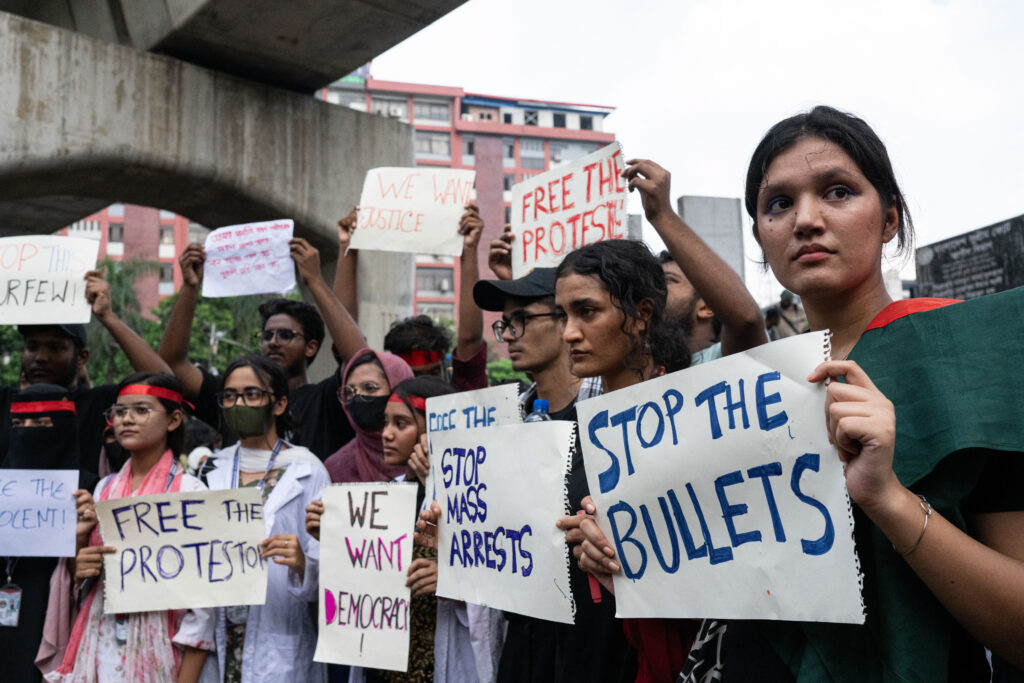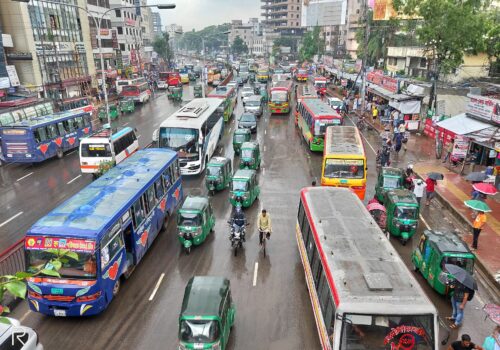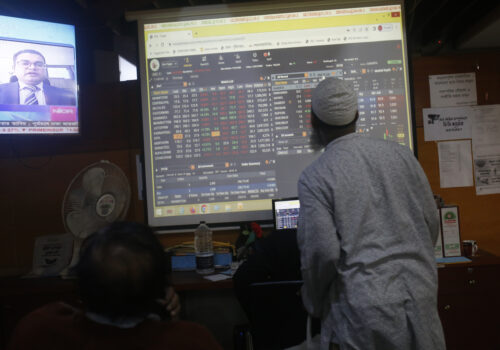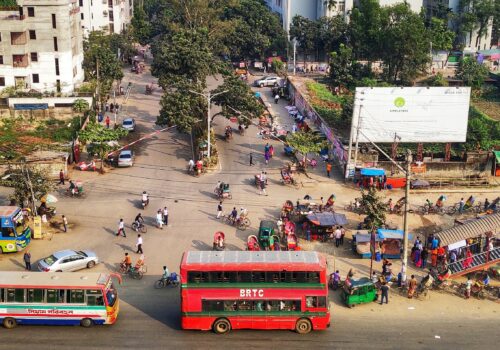A violent crackdown has put Bangladesh at a crossroads
After eleven days of internet blackout, several days of continuous curfew, and a complete shutdown of offices, the Bangladesh government has started to ease some restrictions hoping that it has quelled the popular mobilization that has rocked the country since July 18. But protests have continued and students and people from various walks of life are now staging demonstrations across the country.
At least two hundred people have been killed and thousands more injured in protests that included law enforcement firing on protesters, as Bangladeshi Prime Minister Sheikh Hasina and her government face the most serious popular challenge of the past decade. Many Bangladeshis have been arrested, and cases against thousands of people have been filed.
Two weeks of heightened violence has left visible damage to property in cities across the country. Burned buildings stand as testimonies to anger and mayhem, but what remains unknown is the exact number of deaths, injuries, and missing. The extent of the lethal force used by members of law enforcement agencies is unprecedented in the history of the country, which has all too often experienced bouts of political violence since its inception in 1971.
Despite the claim of a gradual return to normalcy, an overwhelming number of police and soldiers are patrolling the streets of major cities, and a shoot-on-sight order is still in place for curfew violators. The government is on edge, economic activity has stalled, and many citizens are in a state of shock and uncertain about what will come next. For Bangladesh watchers, the question is whether Hasina has weathered the political storm or if the current situation is a larger tempest in the making.
How did it begin?
This episode of protest began in early July as peaceful student demonstrations demanding reform of the quota system in public service. This quota system, which reserved 56 percent of government jobs to various categories, was widely considered by students to be discriminatory and was allegedly used by the government as a means of patronage dispensation. The system was scrapped in 2018 after students launched a movement against it, but it was reinstated by Bangladesh’s High Court in June 2024. The government appealed, and the Supreme Court suspended the verdict, scheduling a hearing for August 6. However, students demanded that the system be reformed by enacting a law. The government insisted that there was nothing it could do while the issue is being litigated. The students felt that this was a stealthy way of reinstating the system.
The situation took an ominous turn after activists aligned with the ruling party swooped in on the demonstrators as they protested Hasina’s comments at a press conference on July 14. In that press conference, Hasina likened the demonstrators with collaborators of the Pakistani army during the war of independence in 1971. As the quota system reserves a percentage of government jobs for the descendants of war of independence veterans, Hasina portrayed opposition to the policy as demeaning to veterans. In the following days, the students organized street protests and called for a general strike, which was confronted with force by police and ruling party activists, leading to the deaths of some students. On July 16, the government closed all educational institutions for an indefinite period.
The situation further deteriorated on July 18, as thousands of protesters joined the students on the street; at least twenty-five people died throughout the country and various public buildings were set ablaze in the capital and elsewhere. The government stopped services. Then the government backtracked and offered to negotiate, but by then the protests had transcended the quota issue.
On July 19, demonstrations engulfed the entire country. The number of deaths, the extent of the spread of protests, and the ferocity of police response made it one of the worst days in the history of the country. Curfew was imposed, the military was called in, a shoot-on-sight order was issued, and internet and broadband services were completely shut down. Yet the violence continued for days, and the death toll continued to mount.
In the meantime, the government met a delegation of the agitating students, and the Supreme Court voided the High Court verdict, issuing guidance to drastically reduce the quota to only 7 percent. However, the government resorted to heavy-handed measures, including allegedly abducting six student leaders of the movement and detaining them without charges. While detained, the student leaders issued a video message on July 28 calling off the movement, but other leaders continued the organize protests.
A perfect storm?
The peaceful student protest transformed into an antigovernment upsurge because of simmering discontent among younger Bangladeshis, as well as in a large segment of the wider society. Economic and political disenfranchisement drove the youth. The economic growth they have heard about for a long time seems to have left them behind. They see very little prospect of a decent job while they witness unbridled corruption and the extravagant lifestyle of a new wealthy class. According to official accounts, unemployment among youth is 15.74 percent and at least 41 percent of youth between the ages of fifteen and twenty-four are not in school, employed, or engaged in job training.
Bangladeshi youth were supposed to be the kingmakers in a free and fair electoral process, the role their predecessors played in the election of 2008. But that opportunity was taken away through fraudulent elections. The government’s disregard for their demands regarding quota reform was symptomatic of a system that cares little for them. Violence perpetrated by the student wing of the ruling party was the instigation that unleashed the anger within the student community.
As for the larger population, resentments originating from rampant corruption by the cronies of the ruling party, impunity enjoyed by party henchmen, utter disregard to the sufferings of the common people, and concentration of power at the hands of one person—Hasina—all came together.
While the regime has a support base, it is bereft of moral legitimacy due to rigged elections. Increasingly, the government also lacked performance legitimacy as the development narrative has been unraveling since summer 2022. Skyrocketing inflation and dwindling foreign reserves have put the government in a precarious situation. In the past decade, Hasina has increasingly relied on force, leading many international organizations, including the Varieties of Democracy Institute, to describe Bangladesh as an autocracy.
What is next for Hasina?
This week, the city streets in Dhaka were filled with cars and buses, and shops and offices are being opened once again. A semblance of normalcy may return in the short run. But the political ground has shifted, and the possibility of a return to the status quo is unlikely. As such, the country is standing at a crossroads.
The number of deaths and the extent of police actions have laid bare the fact that the ruling party and Hasina are entirely dependent on brute force. The upheaval appears to have shaken the regime’s sense of invincibility.
By creating a narrative that her government is facing “terrorists,” Hasina is trying to gain sympathy and tacit support from the international community, or at least their silence. The international community, however, should see through this charade and raise its voice against the gross violations of human rights by a regime that wants to stay in power without a popular mandate.
So, what’s next? Dubbed “Asia’s Iron Lady,” Hasina may double down on more persecution and arrests in an attempt to stem further unrest. This may lead to a closed autocracy in Bangladesh. Alternatively, as discontent continues to grow and demands for her resignation become louder, the country may erupt.
Ali Riaz is a nonresident senior fellow at the Atlantic Council South Asia Center and a distinguished professor at Illinois State University.
Further reading
Tue, Jun 25, 2024
Bangladesh’s air quality is among the world’s worst. What can be done?
EnergySource By Joseph Webster, Natalie Sinha, and Sarah Meadows
Bangladesh’s severe air pollution takes an enormous toll on its people, economy, and environment. While anti-pollution measures can be costly, adopting cleaner fuels, introducing new regulations, and strengthening regional energy integration may benefit the country in the long run.
Thu, May 2, 2024
Is the Bangladesh success story unraveling?
New Atlanticist By Ali Riaz
As the Bangladesh’s system of governance has become more autocratic, social development has received less attention from the government.
Mon, Apr 15, 2024
How Bangladesh can achieve its vision of prosperity
Report By Nina Dannaoui, Joseph Lemoine, Annie (Yu-Lin) Lee
Bangladesh is forging ahead with its Vision 2041, aiming to transform into a developed and prosperous country by 2041.
Image: Protesters hold placards during the demonstration outside the High Court building demanding justice for the victims arrested and killed in the recent countrywide violence. Bangladesh’s government called for a day of mourning on July 30 for victims of violence in nationwide unrest, but students denounced the gesture and that it’s disrespectful to their classmates who were killed during the clashes with police this month so they held a March for Justice.





